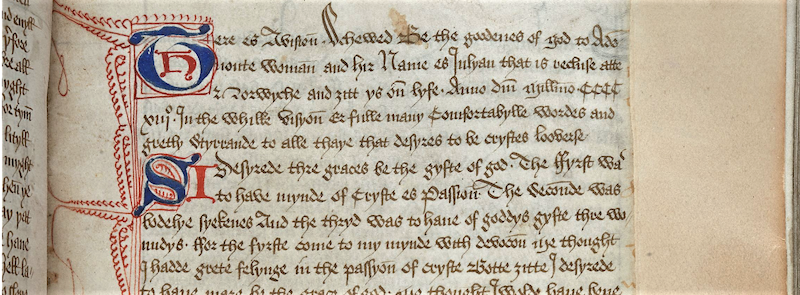Might there be a religious figure who lived centuries ago yet still speaks today? Julian of Norwich certainly comes to mind, also known as St. Julian (though the Roman Catholic Church has not canonized her), Dame Julian, or Mother Julian.
Julian was born near 1342 and her date of death is unknown, though perhaps after 1416. Little is known of her life prior the age of 30, but in May of 1373, she became dangerously ill and near death. During her brief but terrifying illness, she had fifteen visions or “revelations” from God. After her recovery, she wrote about her visions and meditated on them and their meaning. These became known as the “Short Revelations.” Later in life, she wrote an expanded version known as the “Revelations of Divine Love,” a theological classic that has endured to the present day.
Was she a nun? We cannot know for sure; we are not even certain that “Julian” is her given name rather than one taken from the church she entered as a recluse in 1394 (St. Julian’s). For the remainder of her life, she lived as an anchoress in a small set of rooms attached to and yet separate from the church itself. Anchoresses (and anchorites, the male version) would live in just such rooms having three small windows: one opening into the church so that the anchoress could hear and see the mass and receive communion; the second so that a maid or servant could pass food in and remove containers of waste from the cell; and the third through which she could receive and counsel those who came for spiritual advice. Julian was well-known for her wisdom and holiness, which brought many to her. The English mystic Margery Kempe was such a person. She was a noble and notable layperson who made pilgrimages across Europe to sacred sites for prayer, meditation, learning, and, her particular gift, copious bouts of crying while contemplating the cross, crucifixion, pain, and death of Jesus Christ.
As an anchoress, Julian took various vows before being sealed in her cell or rooms until death – vows of poverty, chastity, and obedience. Anchorites took one additional vow over other religious devotees, that of stability, a promise to remain not only in one place but to be walled in with no exit and only the three small windows.
Many of us have felt as though we have lived a type of hermit-like life this past year or so, with limited contact with the outside world. We have felt cut off from family and friends, our church, even the simple act of going out to eat or shop. We have worn masks much as monks, nuns, or even hermits might have worn as identifying habits to mark them as set apart for religious or health reasons. To be sure, the masks we have worn were many and varied rather than cohesive or unifying, but nonetheless a sign that we have followed a discipline for not only our own safety but for that of others.
While being sequestered, we have had the opportunity to live a bit of an anchorite’s or anchoress’ life, with extra time to devote to extra prayer and meditation. Perhaps we also participated with people we have never met before, but with whom we have a common interest in spirituality and faith formation – similar to Julian meeting with others. I wonder what Dame Julian would make of Zoom?
One of Julian’s most famous quotes is, “All shall be well, and all shall be well and all manner of thing shall be well.” Nearly every Christian has heard that tidbit of wisdom at some time on their spiritual journeys. Heaven knows, we have all shared some tough times recently, ranging from inconvenience to ultimate tragedy. We may not have the opportunity to live in desert solitude; however, we still have the opportunity to find a small space to be alone to practice our spiritual exercises – much like someone with an exercise machine might set aside space in the house for a stationary bike or treadmill. Granted, it takes discipline, but then, religious intention takes work, another word for discipline.
So, as we think on Julian today, we can use her words and example to anchor us in the present and to a firm foundation of faith and hope. So it is using ancient words to fill a current need, one that is always present.
God bless.
Image: Image of Divine Love, Add Ms 37790, f. 97r., from the British Library Manuscript, mid 15th century. This work is in the public domain in its country of origin and other countries and areas where the copyright term is the author’s life plus 70 years or fewer. Found at Wikimedia Commons.
Linda Ryan is a co-mentor for an Education for Ministry group, an avid reader, Baroque and Renaissance music lover, and retired. She keeps the blog Jericho’s Daughter. She lives with her three cats near Phoenix, Arizona.

